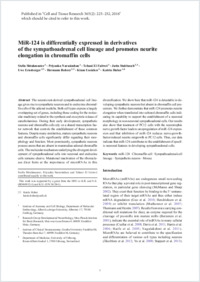MiR-124 is differentially expressed in derivatives of the sympathoadrenal cell lineage and promotes neurite elongation in chromaffin cells
- Shtukmaster, Stella Institute of Anatomy and Cell Biology, Department of Molecular Embryology, Albert-Ludwigs-University, Freiburg, Germany
- Narasimhan, Priyanka Institute of Anatomy and Cell Biology, Department of Molecular Embryology, Albert-Ludwigs-University, Freiburg, Germany
- El Faitwri, Tehani Institute of Anatomy and Cell Biology, Department of Molecular Embryology, Albert-Ludwigs-University, Freiburg, Germany
- Stubbusch, Jutta Research Group Developmental Neurobiology, Max-Planck-Institute for Brain Research, Frankfurt/Main, Germany - Institute of Clinical Neuroanatomy, Goethe University Frankfurt/M, Germany
- Ernsberger, Uwe Research Group Developmental Neurobiology, Max-Planck-Institute for Brain Research, Frankfurt/Main, Germany - Institute of Clinical Neuroanatomy, Goethe University Frankfurt/M, Germany
- Rohrer, Hermann Research Group Developmental Neurobiology, Max-Planck-Institute for Brain Research, Frankfurt/Main, Germany - Institute of Clinical Neuroanatomy, Goethe University Frankfurt/M, Germany
- Unsicker, Klaus Institute of Anatomy and Cell Biology, Department of Molecular Embryology, Albert-Ludwigs-University, Freiburg, Germany
- Huber, Katrin Institute of Anatomy and Cell Biology, Department of Molecular Embryology, Albert-Ludwigs-University, Freiburg, Germany - Department of Medicine, University of Fribourg, Switzerland
-
19.04.2016
Published in:
- Cell and Tissue Research. - 2016, vol. 365, no. 2, p. 225–232
English
The neural-crest-derived sympathoadrenal cell lineage gives rise to sympathetic neurons and to endocrine chromaffin cells of the adrenal medulla. Both cell types express a largely overlapping set of genes, including those coding for the molecular machinery related to the synthesis and exocytotic release of catecholamines. During their early development, sympathetic neurons and chromaffin cells rely on a shared transcription factor network that controls the establishment of these common features. Despite many similarities, mature sympathetic neurons and chromaffin cells significantly differ regarding their morphology and function. Most prominently, sympathetic neurons possess axons that are absent in mammalian adrenal chromaffin cells. The molecular mechanism underlying the divergent development of sympathoadrenal cells into neuronal and endocrine cells remains elusive. Mutational inactivation of the ribonuclease dicer hints at the importance of microRNAs in this diversification. We show here that miR-124 is detectable in developing sympathetic neurons but absent in chromaffin cell precursors. We further demonstrate that miR- 124 promotes neurite elongation when transfected into cultured chromaffin cells indicating its capability to support the establishment of a neuronal morphology in non- neuronal sympathoadrenal cells. Our results also show that treatment of PC12 cells with the neurotrophin nerve growth factor leads to an upregulation of miR-124 expression and that inhibition of miR-124 reduces nerve-growth-factor-induced neurite outgrowth in PC12 cells. Thus, our data indicate that miR-124 contributes to the establishment of specific neuronal features in developing sympathoadrenal cells.
- Faculty
- Faculté des sciences et de médecine
- Department
- Département de Médecine
- Language
-
- English
- Classification
- Biological sciences
- License
- License undefined
- Identifiers
-
- RERO DOC 277382
- DOI 10.1007/s00441-016-2395-9
- Persistent URL
- https://folia.unifr.ch/unifr/documents/305081
Statistics
Document views: 63
File downloads:
- hub_mde.pdf: 166
